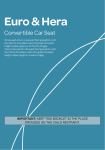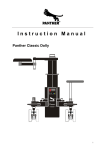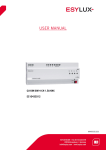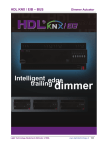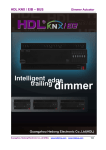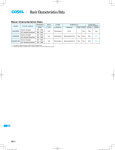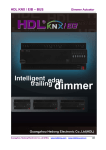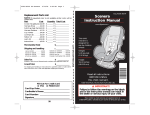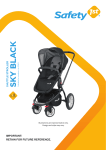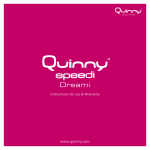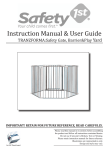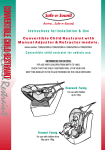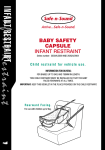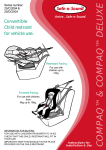Download Instruction Manual - Maxi-Cosi
Transcript
Instruction Manual CONVERTIBLE CAR SEAT CCA 2010 REARWARD-FACING Newborn to approximately 12 months of age FORWARD-FACING 12 months to approximately 4 years of age Illustrations are representative only. Design and style may vary. IMPORTANT: KEEP THIS BOOKLET IN THE PLACE PROVIDED ON THE CHILD RESTRAINT Before You Start Thank you for purchasing this child seat. This product is suitable for toddlers and older children. We welcome you as a valued customer, and trust that your child will enjoy many years of comfort and safety. No child restraint can guarantee absolute protection from a crash. However proper use of this restraint may reduce the risk of injury or death! CONTENTS Page 2 - 3 Warnings Page 4 Parts List Page 5 - 7 Anchorage Fitting Installation / Locking Clip Page 8 Preparing Infant Seat To Fit Your Child Page 9 Base Adjustment Page 11 Correct Rearward Facing Vehicle Position Page 10 Adjusting Tether Strap Page 12 Shoulder Marker Height Rearward Facing Page 13 Rear Facing Installation Page 14 Correct Forward Facing Vehicle Position Page 15 Shoulder Marker Height Forward Facing Page 16 Forward Facing Installation Page 17 The next seat for your child Page 18 Cleaning Instructions For Buckle Page 19 Care Instructions Page 20 Hood Fitment 1 WARNING Read and follow all of the installation instructions for maximum protection. If you have any questions regarding the installation or use of this restraint, please contact IGC Dorel or agent, or a child restraint fitting station authorised by the relevant transport authority, or in New Zealand, to consult the agent for the vehicle. No child restraint can guarantee absolute protection from a crash. However proper use of this restraint may reduce the risk of injury or death! To be used only in a rearward-facing position for an infant until their shoulders reach the lower shoulder height marker (approximately 12 months of age). Then to be used in forwardfacing position until their shoulders reach the upper shoulder height marker (approximately 4 years of age). Continue to use this child restraint until the child reaches this limit. Do not use forward-facing until child’s shoulders are above the lower shoulder height marker. Infants are at risk of serious injury if they face forward too early. Children are at risk of serious injury if they move to booster seats too early. Children that have outgrown this restraint are safest in a booster seat until their shoulders reach the upper shoulder height marker of the booster seat. TO BE USED WITH A LAP-SASH/LAP ONLY SEAT BELT IN THE FRONT/BACK OF MOST CARS WITH FORWARD-FACING SEATS. CHECK THAT THIS CHILD RESTRAINT WILL FIT IN YOUR CAR. NOTE: CHECK THE MEASUREMENTS BETWEEN THE SEAT BACK OF THE REAR SEAT AND ALL FRONT SEATS IN THE VEHICLE IN WHICH THE CHILD RESTRAINT IS INTENDED TO BE USED, TO ENSURE THAT THE SPACE IS SUFFICIENT. THIS RESTRAINT MUST BE ATTACHED TO A CHILD RESTRAINT ANCHORAGE POINT IN THE CAR. REFER TO CAR OWNER’S HANDBOOK FOR LOCATION OF ANCHORAGE POINTS. REFER TO A CHILD RESTRAINT FITTING STATION IF NO ANCHORAGE POINTS ARE IN THE MOTOR CAR. THIS RESTRAINT IS NOT SUITABLE FOR USE WHERE THE ANCHORAGE STRAP MAY FALL INTO A SPLIT IN THE SEAT BACK (E.G. HATCHBACK OR WAGON). NOTE: An extension strap may be needed to fit this child restraint into the vehicle. Extension straps 300mm ref no. 921 and 600mm ref no. 922 and an anchor bolt kit, ref no. 525 are available from various stores. 2 WARNING • DO NOT LEAVE CHILDREN UNATTENDED IN THE CAR. • To ensure that your child gets all the protection designed into this restraint you MUST read and:Use the restraint exactly as shown in the instructions. Fit the restraint firmly to the car seat. Fit the harness firmly to the child. A loose restraint or harness is dangerous. Do not alter or modify this restraint. DO NOT USE A REAR FACING CHILD RESTRAINT WHERE AN AIRBAG IS FITTED IN FRONT OF THE SEATING POSITION. • DO NOT USE THIS SAFETY SEAT WITHOUT ITS COVER • Supervision of children is needed because they may be able to undo buckles. • Failure to follow these instructions may result in your child striking the vehicle’s interior during a sudden stop or crash. • To ensure baby’s back is evenly supported, do not put more than one nappy on the baby and make sure the nappy is not thickly folded at the back. • Repairs must only be done by the manufacturer or agent. • Destroy the restraint if it has been in a severe crash, even if no damage is visible. • Do not allow the restraint to come into contact with polishes, oils, bleach and other chemicals • Clean with mild soap and water. • Do not allow sharp or heavy objects to be loose in the vehicle. • Anything loose can be deadly in a crash. • Premature infants may have difficulty breathing when in a sitting position. • Consult your doctor before using this or any restraint with a premature infant. • Child restraints and their components can become very hot in sunlight. • Always check the restraint for heat before putting a child in the seat. • Make certain children are shaded from direct sunlight while in a well ventilated vehicle. • Do not allow a child to have anything like a bottle, lollipop or ice-cream on a stick. A bump or swerve could cause these objects to injure your child. • Straps may be damaged by unsecured cargo in a collision. Secure or remove hazardous cargo before using this strap. Hatch-back or wagon: Do not use the child restraint where this strap may fall into a split in the seat back. • Always attach hook and remove slack. Please contact IGC Dorel Customer Service with any questions or concerns. 3 PARTS LIST Hook Attachment Hood (if supplied) Tether Strap Insert Belt Mates (if supplied) Stabilising Arm (Design and style may vary) Instruction Manual Adjuster Belt Base adjuster (3 position) PU Anchorage bag SH Recline Arm * Design and style may vary Base Fig 1. Front of vehicle FRONT OF VEHICLE Adjustable Headrest (5 position) Air Protect Technology Adjuster Latch Tether Strap Anchor Fitting Buckle CFA Forward Facing Belt Path Splitter Plate Rearward Facing Belt Path Stabilising Arm Fig 2. Fig 3. 4 ANCHORAGE FITTING INSTALLATION Read and follow all of the installation instructions for maximum protection. If you have any questions regarding the installation or use of this restraint, please contact IGC Dorel or a child restraint fitting station authorised by the relevant State Government body or in New Zealand, to consult the agent for the vehicle. WARNING This restraint must be used with an adult lap or lap-sash seat belt. Do not modify or alter this restraint in any way. Use only IGC Dorel recommended parts and accessories. Protect all webbing from possible damage by sharp edges and corners. Check your vehicle owner’s handbook for the location of correct anchorage points and the possible need for spacers. If a suitable anchorage point cannot be found, contact a child restraint fitting station for recommendations about your vehicle. Some vehicles may have anchor points which are recessed below the vehicle trim, spacers are supplied to raise the anchor point if required. Extension straps and extra fittings are available from various stores. INSTALLING LOCKING CLIP ( OPTIONAL ) Using the seat belt locking clip to convert a lap-sash belt to a lap only belt. NOTE: Locking clip can be fitted on either side depending on the vehicle seatbelt and child restraint configuration. 1. Using a locking clip (Fig A) to convert a lap-sash belt to a lap only belt. 2. Hold the lap and sash straps (Fig B) together. Thread webbing (still pinched) into the locking clip, one side at a time (Fig C & D) 3. Repeat step 2 for the other slot in the locking cip. (Fig E & F ) 4. Feed the straps through the locking clip to remove any slack. 5. If the locking clip is on correctly, it will hold the lap belt securely, if the lap belt slips repeat the previous steps. 6. Locking clips are available from most speciality outlets or from IGC Dorel Customer Service (1300 809 526) A B C D Fig 4. 5 E F IMPORTANT Child restraints must be used correctly to provide proper protection for your child. The new type of clip anchorage system on child restraints must be used in the correct way. Be especially careful to use the clip in the following way. RIGHT Make sure there is no slack in the top strap and the attachment clip is upright in the anchorage fitting. WRONG The clip must not lie flat on the anchorage fitting. Fig 5. FLOOR MOUNTED ANCHORAGES Fig 6. ANCHORAGES IN VERTICAL PANEL AT REAR OF VEHICLE 6 If the car is fitted with a child restraint anchorage point. Locate the anchorage point behind the rear seating position (consult the car owner’s handbook for the location of the anchorage point). Remove the thread plug from the parcel shelf / floor / roof and install the attachment bolt as shown in Fig 7. Attachment Bolt CAUTION DO NOT OVER TIGHTEN THE ATTACHMENT BOLT. MAXIMUM TORQUE 20 Nm (Newton Metre). FRONT OF VEHICLE Front of vehicle Fig 7 If the car is not fitted with a child restraint anchorage point. For sedans only - Drill a 9mm diameter hole in the parcel shelf on the centre - line of the seating position as shown in Fig 8 Install the anchor bolt as shown in Fig 9. For vehicles other than sedans - In Australia, consult your nearest child restraint fitting station or traffic authority for vehicle inspection to find the best, correct position for the placement of the anchorage point, and for the correct attachment bolt length and use of spacers. In New Zealand, consult the agent for the vehicle. WARNING: CHILD RESTRAINTS MUST NOT BE ATTACHED TO UNSOUND METAL OR TO WOOD, OR SYNTHETIC STRUCTURES. WHEN DRILLING THE 9MM HOLE DO NOT DRILL THROUGH FUEL LINES, FUEL TANKS, ELECTRICAL WIRING, OR RADIO SPEAKERS. WEBBING STRAPS MUST BE PROTECTED FROM SHARP CORNERS AND EDGES. THE ANCHOR FITTING MUST BE USED ONLY AS DIRECTED ABOVE. IT MUST NOT BE HOOKED ONTO ANY OTHER OBJECT. Centre line of seating position Attachment Bolt Anchor Fitting Spacers (if required) Vehicle Trim Vehicle Metal Structure Lock Washer Securing Nut Reinforcing Washer FRONT OF VEHICLE FRONT OF VEHICLE Fig 8 Fig 9 7 PREPARING INFANT SEAT TO FIT YOUR CHILD You MUST make these adjustments with your child before you install the child restraint in the vehicle. Please adjust harness according to the infants shoulder height prior to installation. CONFIGURING THE HARNESS BELT FOR SHOULDER HEIGHT. (air) (air) • 1 Lift the harness release lever at the front of seat. • 2 Pull one side of the shoulder strap to loosen 3 Adjuster clamp (Lift lever) • 3 Press red button to release buckle assembly for ease of child fitment. Pull harness straps over sides of infant seat.Place child in seat. 5 Fig 10 Adjuster belt 4 ADJUST HEADREST HEIGHT. • 4 Rotate harness height adjustment levers inward. Move headrest to the proper height and lock into place. • 5 Fasten buckle assembly (See Page 9). Pull the adjuster belt at the front of the seat until the harness belt lies firmly against the child. Fig 11 WARNING Failure to fasten and tighten the harness system correctly can result in serious injury or death. 8 PREPARING INFANT SEAT TO FIT YOUR CHILD TO FASTEN BUCKLE ASSEMBLY Fig 12 STEP 1 STEP 2 STEP 3 Step 1 : Insert one buckle tongue as shown above. Step 2 : Insert the second buckle tongue as illustrated above. Listen for a ‘CLICK’. Step 3 : Remember to always pull up on the harness straps to make sure buckle is locked tightly. BASE ADJUSTMENT * PUSH base adjuster in red under front seat and rock seat to adjust the base. (3 positions) PUSH Fig 14 OW 1. L ID 2. M IGH 3. H 9 AR RE Fig 13 Red base adjuster under front of seat B WA EL R T D PA FA TH CIN G ADJUSTING TETHER STRAP PULL TO LOOSEN PULL BUTTON FIG A PULL TO TIGHTEN PULL BUTTON FIG B Fig 15 TO ADJUST TETHER STRAP: To loosen: Press on the adjuster button with thumb and pull strap back through to loosen anchorage strap using strap which is attached to the seat. FIG A To Tighten: Adjust anchorage strap and remove slack. Pull loose end of strap to tighten. FIG B Front of vehicle FORWARD FACING Fig 16 REARWARD FACING Fig 17 10 CORRECT REARWARD FACING VEHICLE POSITION CORRECT USE Fig 18. CORRECT USE Fig 19. 390mm 640mm Fig 20. ANGLE CONFIGURATION FOR SEAT Position seat ensuring that the angle is no greater than 40˚ from horizontal plane. 40˚ Angular adjustment is achieved by adjusting the base. See page 9 for base adjustment. 11 SHOULDER MARKER HEIGHT REARWARD FACING REARWARD FACING (Newborn to 12 months) Shoulder strap The shoulder straps must be in the slots which are nearest to the child’s shoulders, but not lower than the child’s shoulders. Fig 21 MUST BE REAR FACING WHEN 1 SHOULDERS BELOW THIS LINE Lower label 1 Front of vehicle SHOULDER MARKER Fig 22 To be used only in a rearward-facing position for an infant until their shoulders reach the lower shoulder height marker (approximately 12 months of age). Do not use forward-facing until child’s shoulders are above the lower shoulder height marker. Infants are at risk of serious injury if they face forward too early. NOTE: If the baby’s neck muscles are unable to support their head, then the child should remain rear facing. NOTE: Turn the seat to forward facing when the child’s shoulders reach the lower height marker. 12 REARWARD FACING INSTALLATION 1. Set base in position 3 (High) 2. Swing stabilising arm into position (Fig 23). 3. Place restraint facing rearwards on back seat of vehicle in line with an anchorage strap anchorage point.. 4. Thread the vehicle seat belt through the BLUE belt path at the front of the restraint and fasten buckle 5. Press the child restraint into the vehicle seat and remove belt slack. 6. Attach the anchorage strap to the anchorage point. Adjust until all the slack is removed. Ensure Base of seat is not lifted. Fig 23. Fig 24. PRESS HERE STABILISING ARM RECLINE ARM REARWARD-FACING BELT PATH Fig 25. REARWARD-FACING BELT PATH 13 CORRECT FORWARD FACING VEHICLE POSITION CORRECT USE Fig 26 CORRECT USE Fig 27 INCORRECT USE Fig 28 14 SHOULDER MARKER HEIGHT FORWARD FACING Strap can be next slot above Child Shoulders Strap cannot be more than 25mm below Fig 29. FORWARD FACING (6 months to 4years) The shoulder straps must be in the slots which are nearest to the child’s shoulders, but not more than 25 mm below the child’s shoulders SHOULDERS MUST BE BELOW THIS LINE UPPER label Fig 30. Front of vehicle SHOULDER MARKER To be used in forward-facing position until their shoulders reach the upper shoulder height marker (approximately 4 years of age). Continue to use this child restraint until the child reaches this limit. Do not use forward-facing until child’s shoulders are above the lower shoulder height marker. Infants are at risk of serious injury if they face forward too early. Children are at risk of serious injury if they move to booster seats too early. Children that have outgrown this restraint are safest in a booster seat until their shoulders reach the upper shoulder height marker of the booster seat. NOTE: The child should not sit forward facing until the baby’s neck muscles are able to support their head. CHECK POSITIONING OF STRAPS AND ADJUST HEADREST PRIOR TO INSTALLATION. 15 FORWARD FACING INSTALLATION TODDLER 12MONTHS TO 4YEARS OLD. * PUSH base adjuster in red under front seat and rock seat to adjust the base. (3 positions) Fig 31. PUSH FORWARD-FACING BELT PATH O 1. L W ID 2. M IGH 3. H AR RE Red base adjuster under front of seat B WA EL R T D PA FA TH CIN G 1. Adjust the child restraint to the forward facing position. Fold the Stabilizer Arm if the restraint has been used for rear facing. 2. Adjust the base to suit your child as fitment in some vehicles can be impacted due to the location of anchorage points, or the shape of rear seats, (3 positions base adjustment) 3. Adjust the shoulder straps and headrest to fit your child. Refer to page 8. 4. Place restraint facing forwards on back seat of vehicle inline with an anchorage strap anchorage point. 5. Thread the vehicle seat belt through the YELLOW belt path. 6. Press the child restraint into the vehicle seat and remove slack. 7. Attach the anchorage strap to the anchorage point. Adjust until all the slack is removed. Refer to page 10. NOTE: If the car seatbelt is not long enough to secure the child restraint DO NOT USE SEAT BELT EXTENDERS. NOTE: Infant Insert (where supplied) shall not be used in forward facing position. Only used in seat on bottom two slots when rear facing. Infant Insert 16 THE NEXT SEAT FOR YOUR CHILD SHOULDERS MUST BE BELOW THIS LINE UPPER label Fig 32. Front of vehicle SHOULDER MARKER To be used only in a rearward-facing position until the infant’s shoulders reach the lower shoulder height marker (approximately 12 months of age). Then to be used in forward-facing position until the shoulders reach the upper shoulder height marker (approximately 4 years of age). THE NEXT SEAT (Booster seat) Children that have outgrown this restraint are safest in a booster seat until their shoulders reach the upper shoulder height marker of the booster seat. NOTE: This illustration is representative only. Design and style may vary. Fig 33. 17 CLEANING INSTRUCTIONS FOR BUCKLE Follow the manufacturer’s instructions at all times. Before removal, ensure you have carefully noted the way which the various parts are attached to the seat so as to facilitate reassembly. Your child car seat is equipped with a buckle designed to give your child maximum protection during proper use. When working properly, your buckle should always fasten with an audible “click”. If sticky liquids such as baby food, fruit juice, etc, get into the buckle it may become sluggish and you will not hear a “click”. The buckle should be cleaned by following the steps below. push metal rod into slot Fig 34. Fig 35. Fig 36. 1. Fold seat cover and foam back from buckle, using a flat edged screwdriver gently lift one end of rod out releasing crotch buckle.(repeat for other side) 2. As illustrated in Fig 34 place the buckle unit under running water (40 degrees celcius) Let the water flow through the mouth of the buckle for one minute 3. Simultaneously latch and unlatch the tongues into the buckle several times until a strong audible click is heard. Refer to Fig 35. 4. If you still cannot hear a strong audible click after latching the buckle several times. repeat steps 2 and 3. 5. DO NOT oil any part of the buckle. 6. Allow buckle to dry. 7. Refit crotch buckle ensuring RED button is facing out. 8. Thread the webbings as shown with arrows in Fig 36. 9. Put the 2 metal rods back into the webbing loops and push into the slots. 10. Pull the buckle to make sure that it is fitted properly. 11. If the buckle does not return to original working order, contact IGC Dorel Customer Service on 1300 809 526 18 CARE INSTRUCTIONS • Seat trim may be removed for cleaning. Don’t forget to remove the instruction manual. • Machine wash in cold water, delicate cycle. • Tumble dry 10-15 minutes on low heat. • Do not dry clean. • All other surfaces should be cleaned with a mild soap and water. • Never clean with bleach or spirit-type cleaners. • Do not use the restraint without the cover. • Check the webbing for fraying. REMOVE TRIM FOR CLEANING: Remove Harness Straps From Splitter Plate Fully loosen harness straps. From the back of the restraint, remove both harness straps from splitter plate. Remove Harness Straps Feed harness straps throught headrest. Fig 37. To Remove trims Headrest Trim : Move headrest to highest position. Remove trim from 2 plastic hooks at back of headrest. Pull the plastic harness guide with one hand while pulling off the headrest trim around it. Repeat same process on the other side and remove trim. 2 Seat Trim : Adjust backrest to lowest position. Release the elastic straps on the back of the child restraint. Pull pad off the top of child restraint and around headrest. Replace trim by reverse order. Fig 38. Harness Guides Fig 39. 19 CARE INSTRUCTIONS WARNING VERY IMPORTANT: Only use this child restraint with the cover supplied or a manufacturer-authorized replacement cover with identical shoulder height markers. HOOD FITMENT (If supplied) Hood - To fit the hood, line up the press stud with the one in the trim, press firmly. Refer to Fig 40 Repeat on the next side. Match up velcro on the back of the hood with velcro on seat trim, press the 2 pieces of velcro together firmly. Refer to Fig 41. HOOD BACK VIEW PRESS STUD PUSH VELCRO Fig 40. Fig 41. 20 NOTE: 21 NOTE: 22 GUARANTEE IGC Dorel Pty Ltd warrants your new product to be free from defects in materials and workmanship for 6 years on the seat & 2 years on the trim, from the date of purchase, provided that the product is used in accordance with accompanying recommendations or instructions where provided. The benefit of this warranty is in addition to your rights under the Australian Consumer Law and to other rights and remedies of the consumer under a law in relation to the goods or services to which the warranty relates. IGC Dorel Pty Ltd will provide you with your choice of a refund, repair or exchange (where possible) for this product if it becomes defective within the warranty period. IGC Dorel Pty Ltd will bear the reasonable expense of claiming the warranty. This warranty will no longer apply where the defect is a result of alteration, accident, misuse, abuse or neglect. Please retain your receipt as proof of purchase and contact our Customer Service Centre on Ph: 1300 809 526 or alternatively, via our website at www.igcdorel.com.au for any difficulties with your product. Warranty claims and claims for expense incurred in returning this product can be addressed to our Customer Service Centre at 655-685 Somerville Road, West Sunshine VIC 3020. Hours: 8.30 am to 4.30 pm, Monday to Friday. For New Zealand please contact Customer Service Centre, 14 Sir William Avenue, East Tamaki, Auckland, 2013. Auckland: (09) 274 1040 NZ wide: 0800 628 000 (Toll Free). Hours: 8:00 am - 4:00 pm, Monday to Friday. Our goods come with guarantees that cannot be excluded under the Australian Consumer Law. You are entitled to a replacement or refund for a major failure and compensation for any other reasonably foreseeable loss or damage. You are also entitled to have the goods repaired or replaced if the goods fail to be of acceptable quality and the failure does not amount to a major failure. IMPORTANT: KEEP THIS INSTRUCTION MANUAL IN THE POCKET PROVIDED AT THE REAR OF THE SEAT. Ref # 012162 02/12 Australian Standard AS/NZS 1754 Lic 1491 SAI Global


























